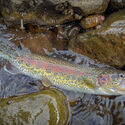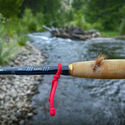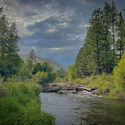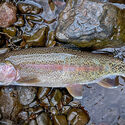Palouse Outdoors: Upland Pursuits – A Fly Fishing Farewell
August 4, 2022
The high cumulonimbus clouds born of afternoon heat, dust particulate, and inexplicable humidity morphed into a nebulous gray bank of doom. Nate and I were headed east into the Blues for an evening of temping mountain rainbows with big dry flies – his last outing before moving to New England two days hence.
"Seems to storm every evening I fish the Blues," I said as we wound out of the foothills into the mountain canyon.
"A little rain just makes the fishing better," Nate replied, ignoring the potential for lightning strikes.
With lightning in mind (or my wish to avoid it), I selected a river reach low in the watershed, expecting the bulk of the storm to pass further into the mountains. It had been about five years since I fished this particular river reach, and I recalled the habitat as mediocre, meaning few good pools and log jams and little variation in depth and riffle-run-pool sequence. Regardless, the few good spots were always worth checking out.
The usual small-talk of flies and tippet sizes ensued on the tailgate as we donned our waders. In his couple years in Walla Walla, Nate had never fished the mountain streams and had no idea what to expect.
"These fish are easy," I said. "Little resident rainbows and juvenile steelhead that are more than happy to take whatever you've got on a 5x tippet. Typical mountain stream trout fishing."
Once geared up, we busted the brush toward the sound of rushing water. I expected to emerge on a stretch of creek flowing in a long straight riffle with a run cutting into the bank about 100 yards upstream. That bank undercut is where I figured we would start, but what we found instead was the result of stream restoration efforts and Mother Nature's handiwork with the recent high-water events.
Nate and I found ourselves standing below a small log jam with a beautiful pool and a couple of similar scenarios stair-stepping their way upstream. This wood addition transformed a formerly unremarkable reach into something I was excited to fish.
Approaching the first pool, I pointed to a deep spot below the wood, looked at Nate, and said, "you can find a few in there." I left him to fish and headed up to the next pool. A large log spanned the channel, and water spilled over near a root wad. Another plunge pool formed there, and a shallow glide edged the depths, presenting several areas with good potential to hold fish.
Starting on the left side of the pool, I cast a fluffy stimulator caddis. A few small fish came to hand from the root wad, many bumping the big fly as it bobbed along but struggling to fit the hair mass into their small gapes. But big or small, watching trout attempt to smash a big dry fly provides endless entertainment.
Turning my attention to the head of the pool, a few more dinks challenged the fly; each brilliantly colored like jewels in a treasure chest. It seemed odd that a bigger fish didn't come from beneath the log. Shifting right a little, I cast toward the glide.
As the fly bounced against the log and floated back into the glide, a fish larger than any I had caught in this stream since 2013 swiftly rose and engulfed the meal, then quickly reminded me what it was like to fight a strong fish on a Tenkara fly rod. The fish was over fourteen inches, thick and deep, quick and fast, and would have been into the drag had I been using a standard rod and reel. Somehow, I thwarted its attempts to blast downstream through the riffles and break me off. As the fish slid into the shallows, I admired its beauty and effort, and released it with the hope that it would grow another year.
Nate and I moved upstream at a snail's pace, stopping to pluck a trout or two from every pocket. The approximate mile-long reach had been completely reborn into what a mountain stream should be. Side channels were cut throughout the floodplain as a result of the frequent and varied log jams. One area presented a side channel that appeared to have been cut this past spring. Reed canary grass was peeled back from the shoreline in a wide swath, and hummocks of root-bound soil clung to existence. Gravel bars were covered in wildflowers and willow and cottonwood saplings, suggesting the riparian forest was regenerating post-disturbance, as nature intended.
A light rumbling overhead soon delivered a soft rain on the outskirts of the storm – a perfect time to call it an evening. We sat on the tailgate with bottles of rich amber suds, talking of the dreams to be realized in the Northwoods. The evening sun cast a warm hue on the distant mountains, illuminating the raindrops and adding deep contrast to the overall setting. A fine Blue Mountain send-off for a good friend. He just might miss this place before long.













Reader Comments(0)